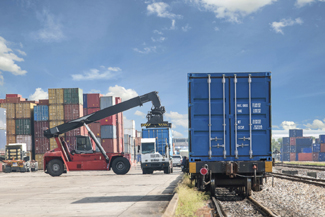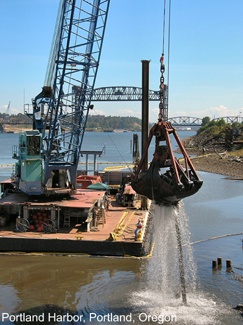Ports Primer: 7.1 Environmental Impacts
Port operations can lead to environmental impacts on air, water and land. Many communities with environmental justice concerns also experience disparities in health outcomes that some researchers have attributed in part, to exposure to emissions from port operations.1 Port authorities and other port operators have an important role to play in mitigating disproportionately high and adverse impacts to human health or the environment resulting from port projects and operations.
The Environmental Protection Agency has legal authority to address some but not all causes of these impacts. For example, EPA has issued a number of regulations where manufacturers of new vehicles and equipment must build cleaner engines that meet tighter emission standards throughout their useful lives. However, EPA can’t mandate the use of clean equipment or control hours of operation of port equipment, or otherwise regulate legacy fleets. EPA also has no authority to regulate land use. DOT uses EPA’s regulations to ensure that new or expanded highway projects are consistent with state clean air goals and Clean Air Act requirements in nonattainment and maintenance areas. EPA Regional Offices consult with other federal agencies and comment on transportation conformity and NEPA environmental analyses of siting a new highway that serves as a freight corridor.
Climate Adaptation
Ports rely on a wide range of vehicles with diesel![]() dieselA type of fuel typically used in a compression-ignition engine. In common maritime use, diesel can refer to several varieties of fuels including Marine Diesel Oil (MDO) and Marine Gas Oil (MGO). Diesel may also be labeled by its sulfur content, such as the case of LSD (low sulfur diesel with less than 500 parts per million (ppm) sulfur) or ULSD (ultra-low sulfur diesel with less than 15 ppm sulfur). engines, which are a source of greenhouse gas (GHG) emissions and affect climate change. This is discussed further on the Air Emissions page.
dieselA type of fuel typically used in a compression-ignition engine. In common maritime use, diesel can refer to several varieties of fuels including Marine Diesel Oil (MDO) and Marine Gas Oil (MGO). Diesel may also be labeled by its sulfur content, such as the case of LSD (low sulfur diesel with less than 500 parts per million (ppm) sulfur) or ULSD (ultra-low sulfur diesel with less than 15 ppm sulfur). engines, which are a source of greenhouse gas (GHG) emissions and affect climate change. This is discussed further on the Air Emissions page.
In addition, due to their coastal locations, seaports are increasingly devoting substantial resources to address risks associated with extreme weather events. Flooding associated with extreme weather events stands out as one of the most significant risks to ports. Flooding has the potential to damage electrical substations, as well as electrical motors on wharf cranes and ground level electric pumps. It can also destroy cargo![]() cargoThe freight (goods, products) carried by a ship, barge, train, truck or plane.. Ports are developing plans to mitigate the effects of climate change-related extreme weather events.
cargoThe freight (goods, products) carried by a ship, barge, train, truck or plane.. Ports are developing plans to mitigate the effects of climate change-related extreme weather events.
Air2
Air pollution is a significant concern at port facilities. Mobile sources at ports release pollutants including particulate matter![]() particulate matterRefers to small particles in the air that can be measured to determine air quality and potential health impacts. Airborne PM can result from direct emissions of particles (primary PM) or from the condensation of certain gases that have themselves been directly emitted or chemically transformed in the atmosphere (secondary PM). PM is often classified by size: PM2.5 and PM10. (PM), nitrogen oxides (NOx), sulfur oxides (SOx), volatile organic compounds (VOCs) and air toxics.
particulate matterRefers to small particles in the air that can be measured to determine air quality and potential health impacts. Airborne PM can result from direct emissions of particles (primary PM) or from the condensation of certain gases that have themselves been directly emitted or chemically transformed in the atmosphere (secondary PM). PM is often classified by size: PM2.5 and PM10. (PM), nitrogen oxides (NOx), sulfur oxides (SOx), volatile organic compounds (VOCs) and air toxics.
Sources of air pollution at ports can include:
| Examples of Sources of Air Pollution at Ports | |
|---|---|
| Transportation Sources | Stationary Sources |
| Trucks | Refineries |
| Marine vessels | Oil and gas storage facilities |
| Locomotives | Power generation |
| Cargo handling equipment | Storage of open piles of coal |
 Air pollution can affect our health in many ways. Exposure to air pollution associated with emissions from diesel engines can contribute to significant health problems—including premature mortality, increased hospital admissions for heart and lung disease, increased cancer risk, and increased respiratory symptoms – especially for children, the elderly, outdoor workers, and other sensitive populations.3 Some sensitive individuals appear to be at greater risk for air pollution-related health effects, for example, those with pre-existing heart and lung diseases (e.g., heart failure/ischemic heart disease, asthma, emphysema, and chronic bronchitis), diabetics, older adults, and children.
Air pollution can affect our health in many ways. Exposure to air pollution associated with emissions from diesel engines can contribute to significant health problems—including premature mortality, increased hospital admissions for heart and lung disease, increased cancer risk, and increased respiratory symptoms – especially for children, the elderly, outdoor workers, and other sensitive populations.3 Some sensitive individuals appear to be at greater risk for air pollution-related health effects, for example, those with pre-existing heart and lung diseases (e.g., heart failure/ischemic heart disease, asthma, emphysema, and chronic bronchitis), diabetics, older adults, and children.
Air pollution also damages our environment. For example, ozone can damage vegetation, adversely impacting the growth of plants and trees. These impacts can reduce the ability of plants to uptake carbon dioxide (CO2) from the atmosphere and indirectly affect entire ecosystems.
Water
 Port operations can have a significant impact on water quality and the health of marine life. Waste from ships and other port activities can result in loss or degradation of habitat areas and can also harm marine life. Known impacts of port operations include:
Port operations can have a significant impact on water quality and the health of marine life. Waste from ships and other port activities can result in loss or degradation of habitat areas and can also harm marine life. Known impacts of port operations include:
- Wastewater: Ships periodically release sewage, wastewater and bilge water, which is wastewater that is often contaminated with oil. Discharges are regulated by federal, state and local governments, including port authorities.
- Ship paint: Leaching of toxic paint additives, meant to prevent barnacles from clinging to ships, can result in health impacts on marine life.
- Stormwater runoff: Stormwater runoff gathers pollutants from paved surfaces at the port and deposits them in the water, often bypassing wastewater treatment plants.
- Nitrogen: Nitrogen is the leading cause of eutrophication in marine systems, where algae blooms use up oxygen in the water and cause fish and shellfish to die.
- Oil spills: Oil contamination can include chronic pollution from runoff, bilge water, and the loading and unloading of oil tankers, as well as larger spills resulting from overfilling tanker ships or tears in a ship’s hull.
- Dredging
 dredgeThe process of removing sediment from harbor or river bottoms for safety purposes and to allow for deeper vessels.: Removing sediment to deepen ship channels can increase the cloudiness of water and disturb contaminated bottom sediment, harm or permanently destroy critical wildlife habitats, and disturb or kill threatened and endangered species.
dredgeThe process of removing sediment from harbor or river bottoms for safety purposes and to allow for deeper vessels.: Removing sediment to deepen ship channels can increase the cloudiness of water and disturb contaminated bottom sediment, harm or permanently destroy critical wildlife habitats, and disturb or kill threatened and endangered species. - Invasive species: Marine animals can be taken into ships through ballast water
 ballast waterFresh or salt water, sometimes containing sediments, held in tanks and cargo holds of ships to increase stability and maneuverability during transit. that is used to help maintain ship balance and then transported across the world to new habitats where they may become invasive species that threaten the balance of natural ecosystems.
ballast waterFresh or salt water, sometimes containing sediments, held in tanks and cargo holds of ships to increase stability and maneuverability during transit. that is used to help maintain ship balance and then transported across the world to new habitats where they may become invasive species that threaten the balance of natural ecosystems.
Risks and Health Impacts4
 Disparities in health outcomes are often a primary environmental justice concern for near port communities. Characterizing these disparities in health outcomes, evaluating their implications, and managing them is a challenge for communities.
Disparities in health outcomes are often a primary environmental justice concern for near port communities. Characterizing these disparities in health outcomes, evaluating their implications, and managing them is a challenge for communities.
EPA has tools that can help communities characterize these risks. These tools can help communities address:
- How to conduct a health risk assessment for exposure to an individual pollutant
- How to conduct a health risk assessment for exposure to a chemical mixture
- How to evaluate risks from multiple chemical stressors
- How to evaluate risks from exposures in children, and impacts of early life exposures
- How to evaluate cancer and non-cancer risks
The following webpage includes EPA tools for human health risk assessment: Air Toxics Risk Assessment Reference Library.
The following webpage includes more information on risk assessment: Risk Assessment.











